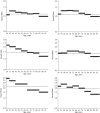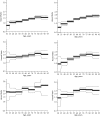Obesity and US mortality risk over the adult life course
- PMID: 23380043
- PMCID: PMC6986179
- DOI: 10.1093/aje/kws325
Obesity and US mortality risk over the adult life course
Abstract
In this study, we analyzed age variation in the association between obesity status and US adult mortality risk. Previous studies have found that the association between obesity and mortality risk weakens with age. We argue that existing results were derived from biased estimates of the obesity-mortality relationship because models failed to account for confounding influences from respondents' ages at survey and/or cohort membership. We employed a series of Cox regression models in data from 19 cross-sectional, nationally representative waves of the US National Health Interview Survey (1986-2004), linked to the National Death Index through 2006, to examine age patterns in the obesity-mortality association between ages 25 and 100 years. Findings suggest that survey-based estimates of age patterns in the obesity-mortality relationship are significantly confounded by disparate cohort mortality and age-related survey selection bias. When these factors are accounted for in Cox survival models, the obesity-mortality relationship is estimated to grow stronger with age.
Figures


Comment in
-
Re: "obesity and US mortality risk over the adult life course".Am J Epidemiol. 2013 Jul 15;178(2):320. doi: 10.1093/aje/kwt117. Epub 2013 Jun 21. Am J Epidemiol. 2013. PMID: 23792893 Free PMC article. No abstract available.
-
The authors reply.Am J Epidemiol. 2013 Jul 15;178(2):321-3. doi: 10.1093/aje/kwt118. Am J Epidemiol. 2013. PMID: 24024240 Free PMC article. No abstract available.
-
Re: "obesity and US mortality risk over the adult life course".Am J Epidemiol. 2014 Feb 15;179(4):529-30. doi: 10.1093/aje/kwt329. Epub 2014 Jan 12. Am J Epidemiol. 2014. PMID: 24418682 No abstract available.
-
The authors reply.Am J Epidemiol. 2014 Feb 15;179(4):530-2. doi: 10.1093/aje/kwt331. Am J Epidemiol. 2014. PMID: 24627920 Free PMC article. No abstract available.
-
Masters et al. Respond.Am J Public Health. 2017 Apr;107(4):505-506. doi: 10.2105/AJPH.2017.303715. Am J Public Health. 2017. PMID: 28272945 Free PMC article. No abstract available.
-
Correction of Selection Bias in Survey Data: Is the Statistical Cure Worse Than the Bias?Am J Public Health. 2017 Apr;107(4):503-505. doi: 10.2105/AJPH.2016.303644. Am J Public Health. 2017. PMID: 28272961 Free PMC article.
-
Editorial: Note About Inaccurate Results Published in the American Journal of Epidemiology and the American Journal of Public Health.Am J Public Health. 2017 Apr;107(4):502. doi: 10.2105/AJPH.2016.303643. Am J Public Health. 2017. PMID: 28272963 Free PMC article. No abstract available.
-
Correction of Selection Bias in Survey Data: Is the Statistical Cure Worse Than the Bias?Am J Epidemiol. 2017 Mar 15;185(6):409-411. doi: 10.1093/aje/kww175. Am J Epidemiol. 2017. PMID: 28399572
-
Editorial: Note About Inaccurate Results Published in the American Journal of Epidemiology and the American Journal of Public Health.Am J Epidemiol. 2017 Mar 15;185(6):407-408. doi: 10.1093/aje/kww176. Am J Epidemiol. 2017. PMID: 28399573 No abstract available.
-
Masters et al. Respond.Am J Epidemiol. 2017 Mar 15;185(6):412-413. doi: 10.1093/aje/kwx011. Am J Epidemiol. 2017. PMID: 28399574 Free PMC article. No abstract available.
References
-
- Wang Y, Beydoun MA. The obesity epidemic in the United States—gender, age, socioeconomic, racial/ethnic, and geographic characteristics: a systematic review and meta-regression analysis. Epidemiol Rev. 2007;29(1):6–28. - PubMed
-
- Calle EE, Kaaks R. Overweight, obesity and cancer: epidemiological evidence and proposed mechanisms. Nat Rev Cancer. 2004;4(8):579–591. - PubMed
-
- Carmichael AR. Obesity as a risk factor for development and poor prognosis of breast cancer. BJOG. 2006;113(10):1160–1166. - PubMed
-
- Carroll KK. Obesity as a risk factor for certain types of cancer. Lipids. 1998;33(11):1055–1059. - PubMed
Publication types
MeSH terms
LinkOut - more resources
Full Text Sources
Other Literature Sources
Medical

